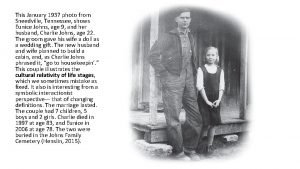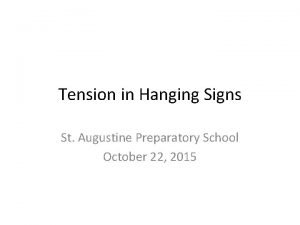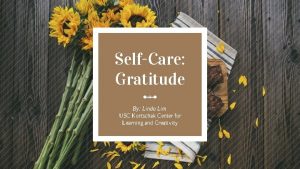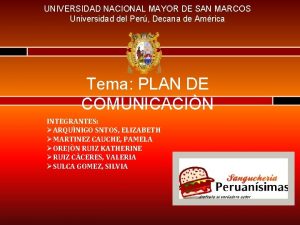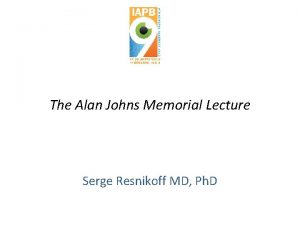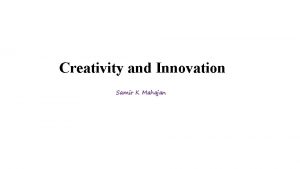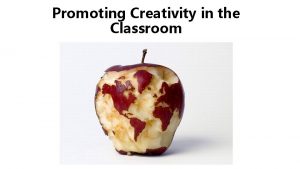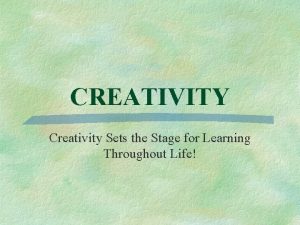Creativity Project Learning Outside the Classroom St Johns













- Slides: 13

Creativity Project Learning Outside the Classroom St John’s Catholic Primary School, Burscough

Outline of project • Themed curriculum throughout school since 2009 • High proportion of boys within the school. (70% Whole school, approx 90% KS 2) • Extensive grounds split into areas of interest. • Good links to local environments and community. • To allocate at least 10% of each class timetable to learning experiences in the outdoor environment and provide a full range of relevant educational experiences.

Objectives • To allocate at least 10% of each class timetable to learning experiences in the outdoor environment and provide a full range of relevant educational experiences. • Extend and support the embodiment of themed curriculum within school. • Enable focus on more sensory teaching and learning, particularly kinaesthetic to provide more suited learning experiences for boys. • Focus on developing PSHE, citizenship and problem solving with strong links to ICT.

Organisation & Involvement • Size of school enabled whole school community to be involved. • All teaching staff worked closely to develop strategy to put project into place. Then implemented through MTP planning, daily planning and themed weeks. Emphasis also on remaining flexible and opportunistic should learning experiences present themselves outside of timetable. • Half termly staff meetings on timetable expectation (10% of week for each class), rotation of areas within school grounds, support and collaboration on ideas for areas within school grounds, local community and school trips, learning experiences that specific outdoor areas could provide.

Organisation & Involvement • Project rolled out consistently throughout the half term through teachers and support staff. This encouraged outdoor learning to become an organic part of everyday teaching and enabled the children to adjust rapidly to the routine. • Teachers used their professional judgement and skills to plan and organise the required outdoor learning time into their weekly routine based on themed MTP, daily planning and suitability of conditions. • Sound planning enabled outside learning opportunities to be developed across all curriculum areas rather than polarised into a single project or subject. • Nature of organisation and roll out means that rather than lasting a set time, outdoor learning can become a continuous and consistent teaching and learning tool throughout the whole school year.

Examples of outdoor learning

Case Studies PSHE and Citizenship Focus As part of Year 1 & 2 topic on Trains and Canals we took a trip to our local train station. We focused the visit on learning about the benefits of having a station in our town and the effects on the people who live in Burscough. Science, Geography and Citizenship Focus Year 2 and 3 visited Platt’s Lake opposite our school to do some pond dipping and hunt for different habitats. They also made posters on how to keep those habitats safe.

Case Studies PSHE, Citizenship and ICT Focus Maths Focus Year 4 and 5 went on a Maths trail around the school. They had to find the answers to calculations to get the next clue. They hunted high and low around the whole of the school – inside and out! The Year 6 children created a map of the school grounds and took photographs to show where bullying hot spots may be, along with quiet areas and noisy areas and added them to the map to make it accessible to the whole school.

Monitoring and Evaluation • School Council devised pupil questionnaires and interviews throughout all year groups to gain feedback on how the children felt about their outside learning experiences. • Discussion in staff meetings to share feelings and thoughts on teaching and learning in the outdoor environment. Shared good practice and ways to overcome barriers. • Support staff feedback sheets incorporating information on outdoor learning experiences enable teachers to plan next steps ensure progression and enjoyment. • Direct comparison of same lessons taught inside and outside the classroom.

Impact of the project • The assessment policy within school has been amended to include termly assessments of Foundation subjects which we have found to be greatly supported by the evidence collected during this project. It has enabled Subject Leaders to gain much more evidence relating to their subject through photographic evidence and feedback. • Results of school council questionnaires showed conclusively that all children within the school found outdoor learning a positive experience and looked forward the sessions. The boys in particular were motivated and found the lessons more accessible.

Impact of the project • Staff felt that through careful planning and preparation in the early stages of a topic that outdoor learning experiences were positive and beneficial. • We found that outdoor learning enabled more concrete links between Every Child Matters and the curriculum and that the teaching of PSHE and citizenship were improved. • The profile of the school has become more visible due to visits and experiences within the local community. • The constraints of risk assessments has on occasion meant that teachers have had to be flexible with their outdoor teaching and learning.

What happens now? • Due to the way that the project was rolled out and implemented we intend to continue to include outdoor learning experiences as an integral part of our school’s curriculum. • Continue to develop the outside learning environment within the school grounds with the support of all staff and parents. Discussions are in place within the school council and staff team on the development of an outdoor classroom. • Developing a School Grounds Development Team involving Governors and parents. • Develop stronger links with the local community through the use of the local area and the people who live and work in it.

Evaluation • The practicalities associated with the weather have on occasion disrupted planned outdoor learning experiences. However on some occasions parents received letters requesting relevant resources such as wellington boots and raincoats to be sent into school with the children which parents have been very supportive of. • Risk assessments and safeguarding constraints have sometimes meant that we could not make the most of outdoor learning, i. e. the snow meant that we had to stay indoors due to health and safety. A huge learning opportunity missed in our opinion!
 Eunice johns and charlie johns
Eunice johns and charlie johns Creativity and play fostering creativity
Creativity and play fostering creativity Advantages of learning outside the classroom
Advantages of learning outside the classroom Advantages of learning outside the classroom
Advantages of learning outside the classroom The sign below hangs outside the physics classroom
The sign below hangs outside the physics classroom Classroom.cloud
Classroom.cloud Usc kortschak center for learning and creativity
Usc kortschak center for learning and creativity Usc kortschak center for learning and creativity
Usc kortschak center for learning and creativity Btech smart classes
Btech smart classes Cuadro comparativo entre e-learning b-learning y m-learning
Cuadro comparativo entre e-learning b-learning y m-learning Wilmer eye institute greenspring
Wilmer eye institute greenspring Universidad st john's cacahuatales 77
Universidad st john's cacahuatales 77 Papa johns mision y vision
Papa johns mision y vision Alan resnikoff
Alan resnikoff
